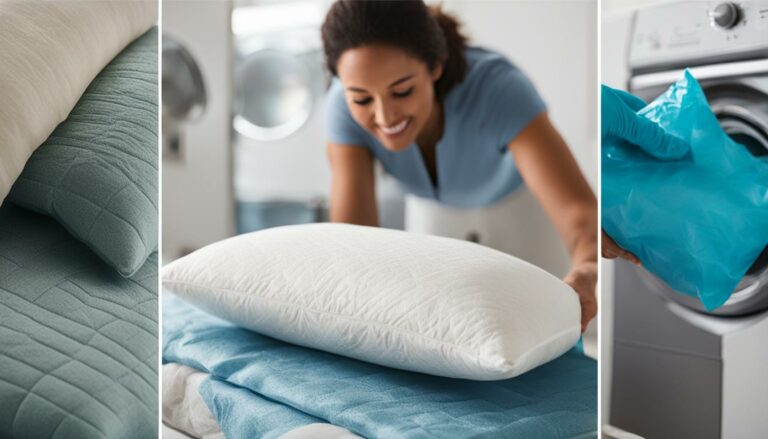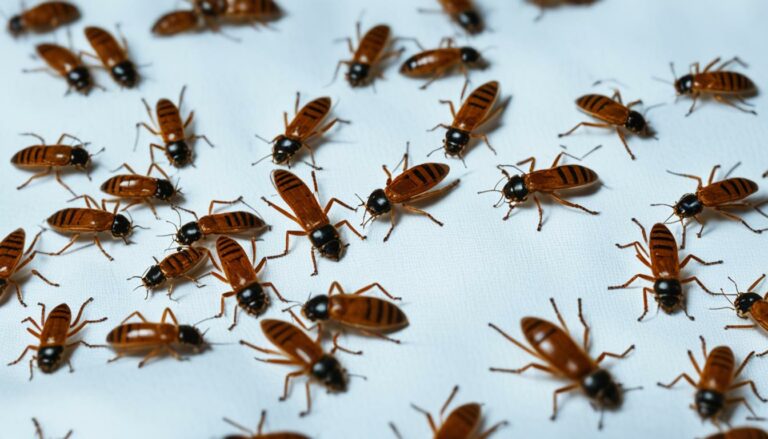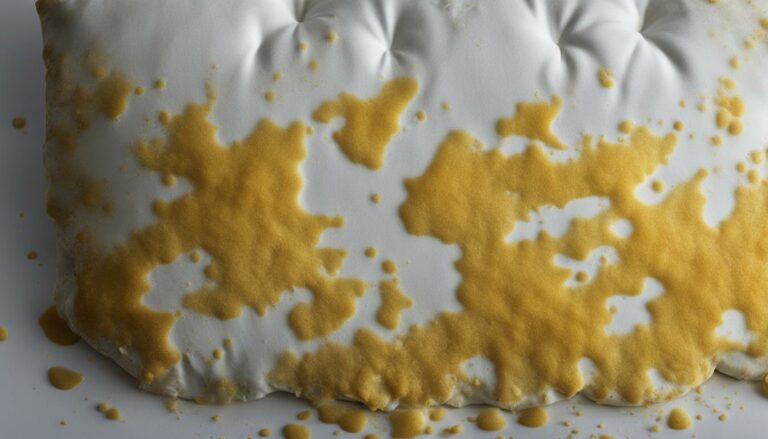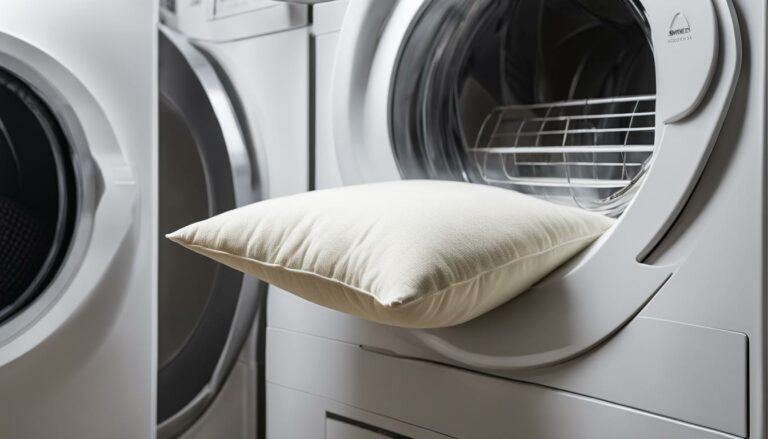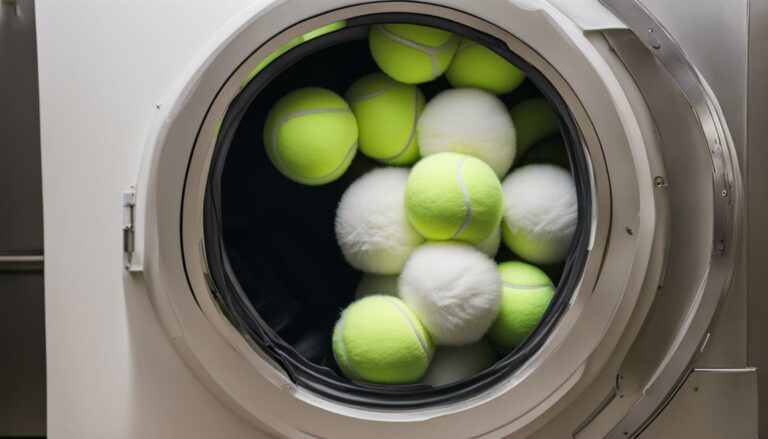Bed Bugs on Pillows: Quick Detection & Solutions
Eric Christie stands as a luminary in the bedding industry, with a career spanning nearly four decades since the early 1980s. His journey through the world of bedding has seen him wear many hats – a manufacturer, designer, and retailer, showcasing his versatility and expertise in Read more...
pillowsandbedsheets.com and its partners may earn a commission if you purchase a product through one of our links
Bed bugs on pillows can be a frustrating and unpleasant problem. These tiny wingless parasites can hide in various places in your bed, including your pillows, causing discomfort and disrupting your sleep. In this article, we will provide you with the essential information you need to detect bed bugs on pillows, get rid of them effectively, and prevent future infestations.
Before we dive into the details, it’s important to understand the signs of a pillow infestation. By recognizing the early signs of bed bugs, you can take swift action and minimize the impact on your sleep environment.
Key Takeaways
- Be aware of the signs of bed bugs on pillows to detect infestations early.
- Effective treatment methods can help you get rid of bed bugs on pillows.
- Using pillow covers and encasements can prevent bed bugs from infesting your pillows.
- Consider seeking professional help for severe bed bug infestations.
- Maintain a clean and bed bug-free sleeping environment to prevent reinfestations.
How to Identify Bed Bugs on Pillows
Bed bugs on pillows can leave behind several signs that indicate their presence. It is important to accurately identify these signs to take prompt action against the infestation.
- Look for small, reddish-brown insects or their eggs on your pillows, sheets, and mattress. These pests are about the size of an apple seed and can be visible to the naked eye.
- Check for dark fecal spots on your pillows. These spots are evidence of bed bug activity and can often be found on the pillowcase, sheets, or mattress.
- If you wake up with itchy bites or welts on your skin, particularly on areas that were in contact with the pillow, it could be a sign of bed bug bites.
It’s important to note that bed bug bites can vary from person to person. Some may have no reaction at all, while others may experience severe itching and allergic reactions. If you suspect bed bugs on your pillows, thoroughly inspect and identify the signs before taking any further action.
Steps to Get Rid of Bed Bugs on Pillows
If you have confirmed bed bugs on your pillows, it’s crucial to take immediate action to eliminate them. Here are the steps you can follow to get rid of bed bugs on pillows:
- Step 1: Launder your pillows: Remove the pillowcases and place the pillows in the dryer on high heat for at least 30 minutes. The heat will help kill any bed bugs and their eggs.
- Step 2: Vacuum your pillows: Use a vacuum cleaner with a brush attachment to thoroughly vacuum your pillows. Pay close attention to the seams, crevices, and folds where bed bugs may be hiding.
- Step 3: Encase your pillows: After laundering and vacuuming, encase your pillows in bed bug-proof pillow covers or encasements. These covers will prevent bed bugs from infesting your pillows again.
- Step 4: Treat your pillows: Apply a bed bug treatment spray or powder specifically designed for pillows. Follow the instructions on the product carefully, ensuring complete coverage. This will help kill any remaining bed bugs and prevent reinfestation.
- Step 5: Monitor and repeat: Continuously monitor your pillows for any signs of bed bugs. If you notice any new infestations, repeat the laundering, vacuuming, and treatment process until the bed bugs are completely eliminated.
By following these steps, you can effectively get rid of bed bugs on your pillows and create a bed bug-free sleeping environment.
Using Pillow Covers and Encasements for Bed Bug Prevention
To prevent bed bugs from infesting your pillows, it’s essential to use protective measures such as pillow covers and encasements. These products act as a barrier, preventing bed bugs from infesting your pillows and making it easier to detect and eliminate any potential infestations.
When selecting pillow covers and encasements, look for those specifically designed to guard against bed bugs. These products are typically made of tightly woven fabric, with a zipper closure that fully encloses the pillow. The zipper should be equipped with a bed bug-proof mechanism, ensuring no gaps or openings for bed bugs to enter or escape.
Regularly inspecting and cleaning the covers and encasements is crucial for effective bed bug prevention. Follow the manufacturer’s instructions regarding washing and care, and be sure to inspect the covers for any signs of bed bug activity, such as stains, shed skins, or bed bug feces.
Here is a summary of the benefits of using pillow covers and encasements for bed bug prevention:
- Act as a barrier, preventing bed bugs from infesting pillows
- Facilitate early detection of bed bug activity
- Easier to clean and maintain
- Protection against bed bug bites
- Peace of mind and improved sleep quality
Remember, using pillow covers and encasements is just one part of a comprehensive bed bug prevention strategy. Regularly inspecting your sleeping area, practicing good hygiene, and taking precautions while traveling are also important steps in keeping your home bed bug-free.
Professional Bed Bug Control for Severe Infestations
In cases of severe bed bug infestations that have spread beyond the pillows and throughout your home, it is advisable to seek professional bed bug control. Professional pest control companies have the expertise, tools, and treatments necessary to effectively eliminate bed bugs and provide long-term prevention strategies. Consulting with a licensed pest control specialist will help assess the severity of the infestation and guide you toward the best course of action.
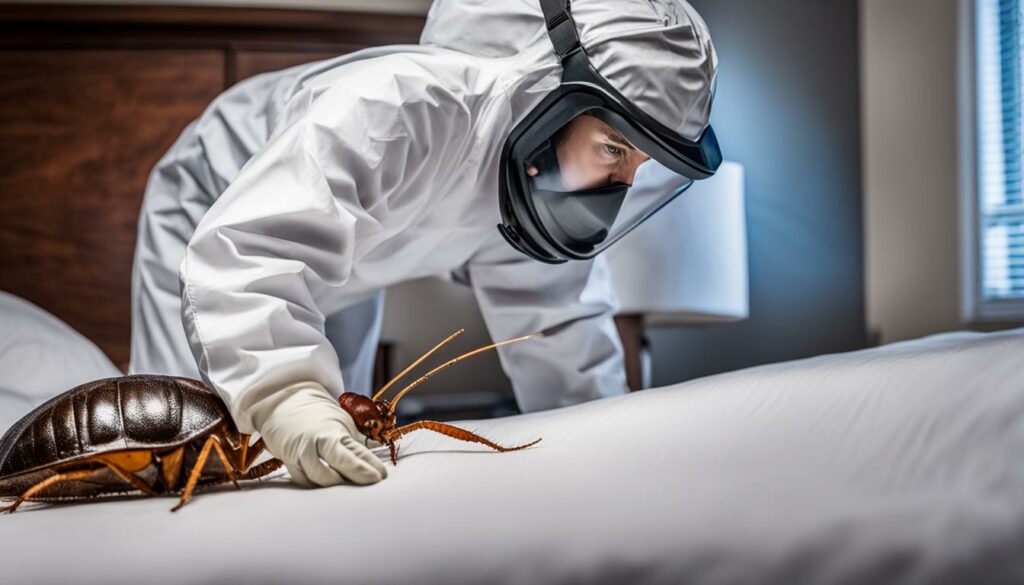
If you are dealing with a severe bed bug infestation, it is crucial to act quickly to minimize the potential health risks, property damage, and psychological stress caused by these persistent pests. Bed bugs reproduce rapidly, making it essential to address the problem promptly.
| Benefits of Professional Bed Bug Control | DIY Bed Bug Control Limitations |
|---|---|
|
|
Professional bed bug control offers a comprehensive approach to address severe infestations effectively. By hiring experts, you can rely on their knowledge and experience to implement targeted treatments and preventive measures that go beyond what is achievable with DIY methods.
Expert Tip: Seek professional bed bug control for severe infestations to ensure thorough eradication and minimize the risk of reinfestation.
Washing and Cleaning Tips for Bed Bug Prevention
Regularly washing your pillows is an important step in preventing bed bug infestations and maintaining a clean and hygienic sleeping environment. While washing alone may not completely eliminate bed bugs, it can help reduce their numbers and remove allergens and debris that may attract them.
Follow these tips to enhance the effectiveness of washing in your bed bug prevention efforts:
1. Use Hot Water and High Heat
When washing your pillows, use hot water and high heat settings for both washing and drying. Bed bugs and their eggs are sensitive to heat, and exposing them to high temperatures can help kill them. Set your washing machine to the hottest water setting recommended for your pillow material and add a mild detergent.
After washing, place your pillows in the dryer and use the highest heat setting. Be sure to dry them thoroughly to prevent moisture buildup, which can attract more bed bugs.
2. Consider Adding Essential Oils
“Essential oils like lavender, tea tree, and eucalyptus have been found to have insect-repelling properties and can be used as natural deterrents against bed bugs.”
You can enhance the bed bug-fighting power of your pillow wash by adding a few drops of essential oils known to repel insects. Lavender, tea tree, and eucalyptus essential oils are commonly used for this purpose. Add a few drops to your detergent or fabric softener during the washing process.
3. Vacuum Your Pillows
In addition to washing, regularly vacuum your pillows to remove any bed bugs, eggs, or shed skin that may be present. Use the upholstery attachment of your vacuum cleaner and ensure thorough coverage of the pillow surface, paying attention to seams and folds where bed bugs often hide.
4. Encase Your Pillows
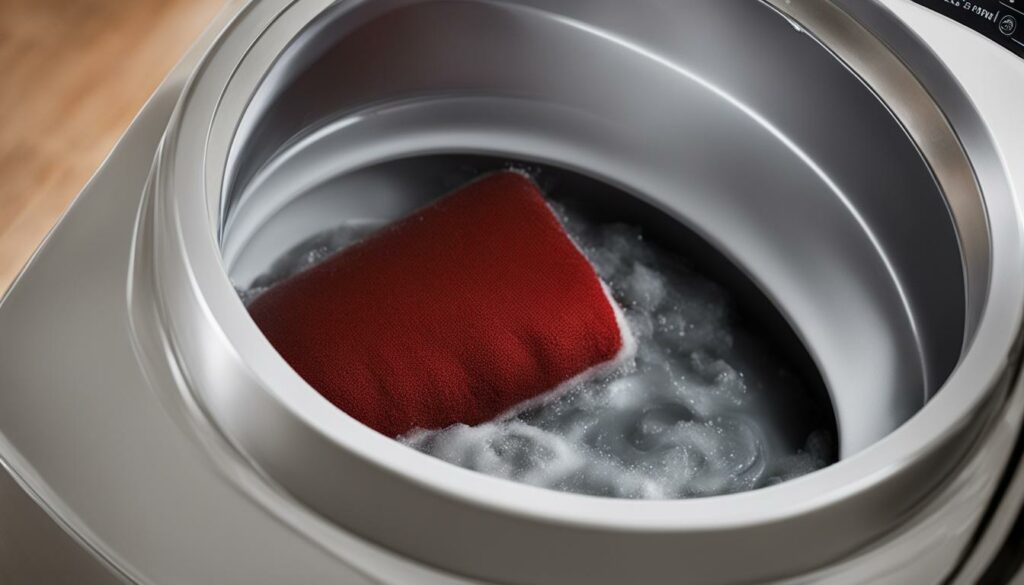
Consider using pillow encasements or covers designed specifically to protect against bed bugs. These encasements act as a physical barrier that prevents bed bugs from infesting your pillows, making it easier to detect and eliminate any potential infestations. Make sure to choose encasements that are labeled as bed bug-proof or bite-proof.
Remember to regularly inspect and clean the encasements according to the manufacturer’s instructions to ensure their effectiveness.
By following these washing and cleaning tips, you can further fortify your bed bug prevention efforts and maintain a clean sleeping environment.
Bed Bug Prevention While Traveling
When you travel, it’s essential to take precautions to prevent bed bugs from hitchhiking and infesting your home. Bed bugs can easily cling to your luggage and belongings, waiting for an opportunity to spread to your living space. By following these tips, you can minimize the risk of bringing bed bugs home from your trip:
1. Inspect Your Accommodation
Upon arrival at your accommodation, perform a thorough inspection to check for any signs of bed bugs. Look for small insects or dark fecal spots on the mattress, sheets, and furniture. If you notice any indications of infestation, request a room change or consider finding an alternative place to stay.
2. Keep Your Luggage Elevated
Instead of placing your luggage on the bed or floor, keep it elevated on a luggage rack or in the bathroom. This reduces the likelihood of bed bugs climbing into your belongings.
3. Use Protective Covers
Consider using bed bug-proof encasements for your luggage and backpacks to create a barrier against potential infestations. These covers can help prevent bed bugs from entering your belongings and ensure a safe return home.
4. Pack Sealable Plastic Bags
Before leaving for your trip, pack sealable plastic bags to separate dirty and clean laundry. This prevents any potential bed bugs from spreading to your clean clothes and belongings.
5. Avoid Placing Belongings on the Bed
While unpacking or getting ready, refrain from placing your belongings on the bed. Opt for using a designated area or a luggage stand to keep your items organized and bed bug-free.
6. Wash and Dry Clothes Immediately
When you return from your trip, wash your clothes, including those that were not worn, in hot water and dry them on high heat. This effectively kills any potential bed bugs that may have hitchhiked back with you.
7. Vacuum Your Luggage
After unpacking, thoroughly vacuum your luggage, paying close attention to seams and folds where bed bugs may hide. Dispose of the vacuum bag in a sealed plastic bag to prevent any potential escape.
By following these preventive measures, you can minimize the chances of bringing bed bugs home from your travels and ensure a bed bug-free environment.
| Precautions | Benefits |
|---|---|
| Inspect your accommodation | – Identify potential bed bug infestations early – Take necessary action to switch rooms or find alternative accommodation |
| Keep your luggage elevated | – Reduce the risk of bed bugs crawling into your belongings – Prevent potential infestation at home |
| Use protective covers | – Create a barrier against bed bugs entering your luggage – Ensure a safe and bed bug-free return home |
| Pack sealable plastic bags | – Separate dirty and clean laundry to prevent spreading bed bugs – Maintain cleanliness and hygiene during travel |
| Avoid placing belongings on the bed | – Minimize contact with potential bed bug hiding places – Prevent bed bugs from crawling into your items |
| Wash and dry clothes immediately | – Eliminate any potential bed bugs on clothing and prevent infestation – Maintain a bed bug-free wardrobe |
| Vacuum your luggage | – Remove any potential bed bugs hiding in your luggage – Prevent reintroduction of bed bugs into your home |
The Importance of Early Detection and Action
Early detection and prompt action are key factors in effectively controlling bed bug infestations. The sooner you identify signs of bed bugs on your pillows, the easier it will be to eliminate them and prevent their spread to other areas of your home. By taking immediate measures, you can minimize the impact of a bed bug infestation and protect your sleeping environment.
To ensure early detection, it is crucial to conduct regular inspections and maintain vigilant monitoring of your pillows and bedding. Look out for signs such as small, reddish-brown insects or their eggs on your pillows, sheets, and mattress. Dark fecal spots and itchy bites on your skin after sleeping can also indicate the presence of bed bugs.
Once you have detected signs of bed bugs on your pillows, it is important to take immediate action to prevent further infestation. Start by isolating the infested pillows in a sealed plastic bag to prevent the bugs from spreading. Then, follow the necessary treatment measures, such as washing your pillows in hot water or using appropriate insecticides as recommended by professionals or product instructions.
By addressing the problem early on, you can effectively control and eliminate the bed bug infestation, ensuring a safe and peaceful sleeping environment. Remember, prevention is always better than cure, so it is essential to continue with regular inspections and take proactive measures to minimize the risk of future infestations.
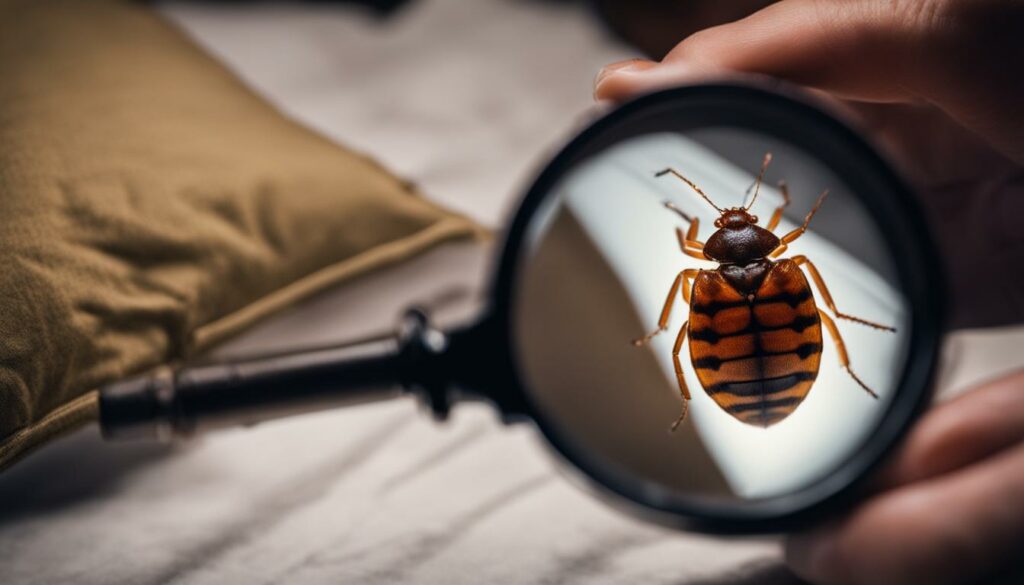
Regular inspections and immediate action are critical in the fight against bed bugs on pillows. By detecting the signs early and taking swift measures, you can protect your sleep environment and prevent the spread of these pests throughout your home.
Potential Risks and Limitations of DIY Bed Bug Treatment
While DIY bed bug treatment can be cost-effective and convenient, it’s important to be aware of its potential risks and limitations. DIY methods may not be as effective as professional treatments, especially for severe infestations. Additionally, improper use of insecticides or other treatment products can pose health risks to yourself and your family. Always follow instructions carefully and consider seeking professional help for complex or persistent bed bug problems.
Before attempting a DIY bed bug treatment, it’s crucial to understand the potential risks involved. Although DIY methods may seem like a quick and affordable solution, there are certain limitations and hazards that you need to consider.
Potential Risks of DIY Bed Bug Treatment
- Health hazards: Improper handling or misuse of insecticides can lead to health risks, particularly if you come into direct contact with the chemicals. Some people may be more sensitive to these substances, leading to allergic reactions or respiratory problems. It’s essential to wear appropriate protective gear and ventilate the area properly during treatment.
- Ineffectiveness: DIY treatments often do not utilize professional-grade products or techniques, making them less effective in eliminating bed bugs, especially in severe infestations. Bed bugs are resilient pests that can hide in tiny cracks and crevices, making it challenging to reach them with DIY methods alone.
- False sense of security: DIY treatments may give you a false sense of security, making you believe that you’ve eradicated the infestation completely. However, bed bugs can easily reproduce and reinfest your home if not properly eliminated. Professional pest control treatments are designed to ensure long-term bed bug prevention.
Limitations of DIY Bed Bug Treatment
DIY bed bug treatment methods have certain limitations that can impact their effectiveness:
- Lack of expertise: Professional pest control technicians undergo extensive training and have the necessary knowledge and experience to identify the extent of the infestation and apply targeted treatments. DIY methods may not address all the areas of infestation, leading to incomplete elimination.
- Difficulty in locating hidden bed bugs: Bed bugs are experts at hiding in hard-to-reach areas, such as cracks in furniture, walls, and baseboards. DIY treatments may not effectively target these hiding spots, allowing bed bugs to survive and reproduce.
- Reinfestation risk: Without proper preventive measures, DIY treatments may not fully prevent reinfestation. Bed bugs can easily spread from neighboring infested areas or via infested items, making it essential to take comprehensive measures to safeguard your home.
When it comes to severe or persistent bed bug infestations, it’s recommended to seek professional help. Pest control experts have the necessary knowledge, tools, and techniques to eliminate bed bugs effectively and offer long-term prevention strategies.
Remember: It’s crucial to prioritize your safety and the effectiveness of the treatment when dealing with bed bugs. If you have concerns or doubts about DIY methods, consult with a professional pest control company to ensure thorough eradication of bed bugs in your home.
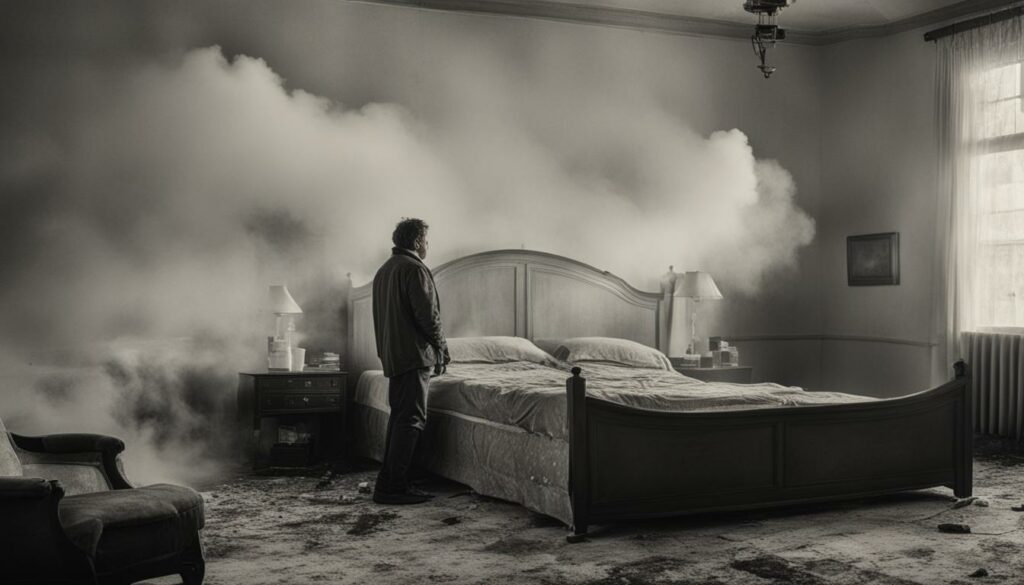
The Emotional Impact of Bed Bugs and Seeking Support
Dealing with a bed bug infestation can have a significant emotional impact on your well-being. The presence of these tiny pests can leave you feeling anxious, frustrated, and overwhelmed. It’s essential to acknowledge and address these emotions during the process of eliminating bed bugs from your home.
“The emotional toll of bed bugs can be just as challenging as the physical task of getting rid of them.”
If you’re struggling with the emotional impact of bed bugs, remember that you are not alone. Seeking support from friends, family, or professional counselors can provide you with the understanding and guidance you need. Talking about your experiences and concerns can help alleviate the stress and isolation that often accompanies a bed bug infestation.
“Sharing your experiences and seeking support can create a sense of relief and reassurance.”
Additionally, adopting self-care practices can help you navigate the emotional aspects of dealing with bed bugs. Take time for yourself and engage in activities that promote relaxation and stress reduction. This can include practicing mindfulness, engaging in hobbies, or seeking professional help to address anxiety or sleep disturbances.
Remember, by seeking support and caring for your emotional well-being, you can better cope with the challenges posed by a bed bug infestation.
Tips for Seeking Emotional Support during a Bed Bug Infestation
- Reach out to trusted friends or family members and share your experiences. They can provide a listening ear and offer emotional support.
- Consider joining online forums or support groups where you can connect with others who have gone through similar experiences.
- Consult with a professional counselor who can help you navigate the emotional challenges associated with a bed bug infestation.
- Practice self-care techniques such as deep breathing exercises, meditation, or engaging in activities that bring you joy and relaxation.
Remember, seeking support is a sign of strength and can help you maintain your emotional well-being as you work towards eliminating bed bugs from your home.
Maintaining a Bed Bug-Free Environment
Once you have successfully eliminated bed bugs from your pillows and home, it’s crucial to take proactive measures to maintain a bed bug-free environment. By implementing these practices, you can prevent future infestations and ensure a peaceful and comfortable living space.
Regular Cleaning and Vacuuming
Keeping your home clean is essential in preventing bed bug reinfestations. Make sure to regularly vacuum your floors, furniture, and mattresses, paying special attention to cracks, crevices, and other potential hiding spots. Dispose of the vacuum bag or empty the canister in a sealed plastic bag to avoid spreading any captured bed bugs.
Sealing Potential Entry Points
Bed bugs can enter your home through small cracks and gaps in walls, baseboards, and furniture. To prevent their entry, seal these potential access points using caulk or sealant. Inspect and repair any damaged window screens or door frames to ensure they are secure and free from openings.
Decluttering and Organizing
A cluttered and disorganized environment provides numerous hiding spots for bed bugs. Regularly declutter your living spaces, removing unnecessary items and ensuring that belongings are neatly organized. This not only helps maintain a bed bug-free environment but also makes it easier to detect any potential infestations.
Inspecting Second-Hand Items
If you’re considering purchasing second-hand furniture, clothing, or other items, thoroughly inspect them for any signs of bed bugs before bringing them into your home. Pay close attention to seams, folds, and crevices where bed bugs may hide.
Using Bed Bug-Proof Covers and Encasements
Investing in bed bug-proof covers and encasements for your mattresses, pillows, and box springs can provide an added layer of protection against bed bug infestations. These specially designed covers create a barrier that prevents bed bugs from accessing these areas, making it easier to detect and eliminate any potential infestations.
| Practices to Maintain a Bed Bug-Free Environment | Benefits |
|---|---|
| Regular cleaning and vacuuming | Prevents bed bugs from hiding and reproducing |
| Sealing potential entry points | Blocks bed bug access to your home |
| Decluttering and organizing | Reduces hiding spots and makes infestations easier to detect |
| Inspecting second-hand items | Avoids introducing bed bugs from infested items |
| Using bed bug-proof covers and encasements | Creates a protective barrier against bed bug infestations |
By incorporating these practices into your daily routine, you can maintain a bed bug-free environment and enjoy a peaceful and restful sleep. However, it’s important to stay vigilant and continue monitoring for any signs of bed bugs. If you suspect a new infestation, take immediate action to prevent it from worsening and seek professional assistance if necessary.
Conclusion: Enjoy a Peaceful, Bed Bug-Free Sleep
Dealing with bed bugs on pillows can be a stressful and uncomfortable experience, but with the right approach, you can reclaim your sleeping space and enjoy a peaceful, bed bug-free sleep. By following the strategies outlined in this guide, such as early detection, effective treatment, and preventative measures, you can protect yourself from bed bug infestations and ensure a hygienic sleeping environment.
Remember, taking immediate action is key. If the infestation persists or worsens despite your efforts, don’t hesitate to seek professional assistance. Bed bug experts have the knowledge, tools, and treatments to effectively eliminate these pests and provide long-term prevention strategies.
Don’t let bed bugs disrupt your quality of life. You deserve to sleep soundly and wake up refreshed. By implementing the tips and techniques shared in this article, you can enjoy a good night’s sleep in a bed bug-free environment and minimize the risks associated with these persistent pests. Rest easy, knowing that you have the knowledge and resources to keep bed bugs at bay.
FAQ
How can I identify bed bugs on pillows?
Look for small, reddish-brown insects or their eggs on your pillows, sheets, and mattress. You may also notice dark fecal spots or wake up with itchy bites or welts on your skin, particularly on areas that were in contact with the pillow.
What steps can I take to get rid of bed bugs on pillows?
To eliminate bed bugs on pillows, you can follow these steps: 1) Remove and isolate the infested pillow. 2) Vacuum the pillow and surrounding areas. 3) Launder the pillow using high heat. 4) Dry the pillow thoroughly. 5) Consider using bed bug spray or mattress encasements.
How can I prevent bed bugs from infesting my pillows?
To prevent bed bug infestations on your pillows, use protective measures such as pillow covers and encasements. Regularly inspect and clean these covers, and consider using bed bug traps to monitor for infestations.
Should I seek professional help for severe bed bug infestations on my pillows?
Yes, in cases of severe bed bug infestations that have spread throughout your home, it is recommended to seek professional help from pest control companies. They have the expertise, tools, and treatments to effectively eliminate bed bugs and provide long-term prevention strategies.
How can I wash and clean my pillows to prevent bed bug infestations?
While washing alone may not eliminate bed bugs, you can enhance its effectiveness by following these tips: 1) Use hot water and high heat to wash and dry your pillows. 2) Inspect the pillows before and after washing. 3) Consider using a bed bug laundry additive or tea tree oil to repel bed bugs.
What precautions should I take to prevent bringing bed bugs home from my travels?
To prevent bringing bed bugs home from your trips, consider these precautions: 1) Inspect your hotel room for signs of bed bugs. 2) Keep your luggage elevated and away from the bed or floor. 3) Seal your luggage in plastic bags during transit. 4) Launder your clothes and vacuum your luggage upon returning home.
Why is early detection and action important in controlling bed bug infestations?
Early detection and prompt action are crucial because the sooner you identify signs of bed bugs on your pillows, the easier it will be to eliminate them and prevent their spread to other areas of your home. Regular inspections, vigilant monitoring, and immediate treatment measures can minimize the impact of a bed bug infestation.
Are there any risks or limitations to DIY bed bug treatment?
Yes, DIY bed bug treatment may not be as effective as professional treatments, especially for severe infestations. Improper use of insecticides or other treatment products can also pose health risks to yourself and your family. It’s important to follow instructions carefully and consider seeking professional help for complex or persistent bed bug problems.
How can I deal with the emotional impact of bed bugs and seek support?
Dealing with a bed bug infestation can be emotionally challenging. It’s normal to feel anxious, frustrated, and overwhelmed during the process. Seek support from friends, family, or professional counselors to share your experiences, seek guidance, and adopt self-care practices to help you navigate the emotional aspects of dealing with bed bugs.
How can I maintain a bed bug-free environment after eliminating bed bugs from my pillows?
To maintain a bed bug-free environment, consider these practices: 1) Regularly inspect your pillows and bedding for signs of bed bugs. 2) Vacuum and clean your bedroom regularly. 3) Minimize clutter in your living space. 4) Avoid purchasing used furniture or mattresses without proper inspection.
Eric Christie stands as a luminary in the bedding industry, with a career spanning nearly four decades since the early 1980s. His journey through the world of bedding has seen him wear many hats – a manufacturer, designer, and retailer, showcasing his versatility and expertise in Read more...


